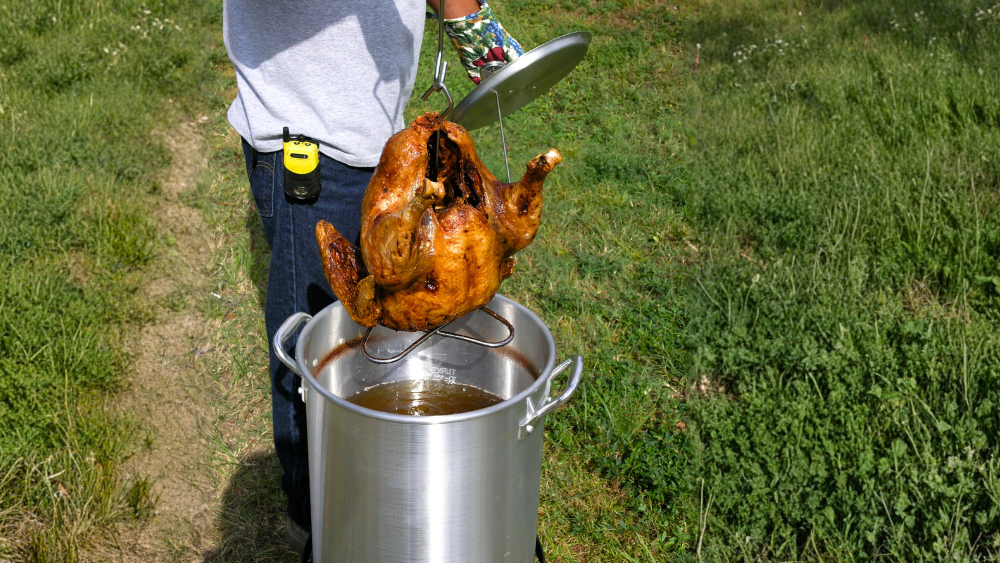Turkey frying can deliver amazing flavor, but hot oil and open flame raise real safety risks. With the right prep, equipment, and location you can reduce those risks and enjoy the feast.
Turkey frying safety key takeaways
- Never use an oil turkey fryer indoors or in a garage. Keep it outside on level ground and away from buildings.
- Thaw and dry the bird completely before frying. Partial thawing and excess moisture cause dangerous oil boil-overs.
- Monitor oil temperature closely and shut off the burner if you see smoke. Keep a Class K or multi-purpose ABC extinguisher handy. Never use water on a grease fire.
- If you are in a campground, confirm local rules first. Many parks restrict or ban oil fryers during fire restrictions and some limit where LP-gas appliances can be used.
Before you buy or set up a turkey fryer
- Choose your location wisely
Set up outdoors on a flat, stable surface at least 10 feet from buildings and never under eaves, awnings, trees, or carports. Do not use on wooden decks or in garages. - Check the weather
Skip frying in rain, snow, or high winds which can cause flare-ups or tip-overs. - Gather safety gear
Heat-resistant gloves, long sleeves, closed-toe shoes, a thermometer for oil temperature, and a Class K or ABC extinguisher. Never plan to use water on hot oil. - Know the risks
NFPA advises against consumer oil fryers because large volumes of 350–375°F oil can tip, splash, and cause severe burns or fires. If you prefer frying, consider an oil-less infrared fryer as a lower-risk alternative.
Food safety prep that prevents fires
- Thaw the turkey completely
- Refrigerator method: allow about 24 hours per 4–5 lb of turkey. A 16 lb bird needs 4 days. Keep at 40°F or below.
- Cold-water method: submerge in cold water, change water every 30 minutes, and cook immediately after thawing.
Never thaw at room temperature. Germs multiply quickly between 40°F and 140°F.
- Pat the bird very dry
Water on the surface triggers violent boil-overs when the turkey is lowered into oil. - Mind the fill line
Overfilling the pot is a top cause of overflow and fire. Follow the fryer’s manual for oil level and test with water first if the manufacturer recommends it.
Frying day checklist
- Position the fryer and LP cylinder so wind blows heat away from the cylinder and any structure. Keep pets and kids well away.
- Preheat slowly and watch the thermometer. If oil smokes, turn off the burner immediately and let it cool. Most incidents happen while preheating.
- Lower the turkey slowly using the supplied rack and hook. Wear gloves and long sleeves.
- Maintain oil around 350–375°F. Never leave the fryer unattended.
- If fire occurs, use your extinguisher and call 911. Do not use water.
- Cook the turkey to an internal temperature of 165°F in the breast, thigh, and wing joint. Verify with a food thermometer.
LP-Gas and placement notes
Follow LP-Gas codes and manufacturer instructions for cylinder use and placement. As a general reference, NFPA 58 and local fire codes set minimum distances between LP containers and ignition sources and require open-air use for appliances like fryers. Check your city or county rules.
RV camping: can you fry a turkey at the campsite?
Frying at a campsite requires extra planning and sometimes it is not allowed.
1) Confirm campground rules first
-
- Some parks allow propane fire pits but do not allow oil fryers, especially during fire restrictions. Check with your local campground or county fire authority.
- During high fire danger, parks may encourage propane stoves instead of open flame cooking.
- Special event and tent policies often restrict deep fryers or require specific extinguisher types and clearances.
2) Choose a safe site layout
-
- Keep the fryer far from RV awnings, slide-outs, propane compartments, and vehicles. Maintain clear space on all sides and never fry under an awning. General outdoor guidance is at least 10 ft from structures.
- Place the fryer so wind carries heat away from the LP cylinder and RV.
3) Cylinder transport and handling
-
- Transport cylinders upright, secured, leak-free, and with valves closed. Comply with NFPA 58 and any campground or state limits on cylinder size near tents or structures.
4) Respect local burn bans
-
- During burn bans, wood or charcoal fires are usually restricted. Propane devices may or may not be allowed. Oil fryers are often prohibited. Always check current restrictions before you go.
Bottom line for campers
If a campground does not explicitly allow turkey frying with oil, choose a propane grill or an oil-less fryer instead. You will still get great results and you will be within park rules.
After the feast
- Let the oil cool completely before moving the pot.
- Strain and store oil in a sealed container or recycle it through a local program.
- Inspect hoses and connections before putting your fryer away.
Sources
U.S. Fire Administration (USFA): Turkey Fryer Fire Safety Infographic
National Fire Protection Association (NFPA): Thanksgiving Safety Tips
Centers for Disease Control and Prevention (CDC): Preparing Your Holiday Turkey Safely
USDA Food Safety & Inspection Service: Turkey Basics – Safe Thawing & Cooking
